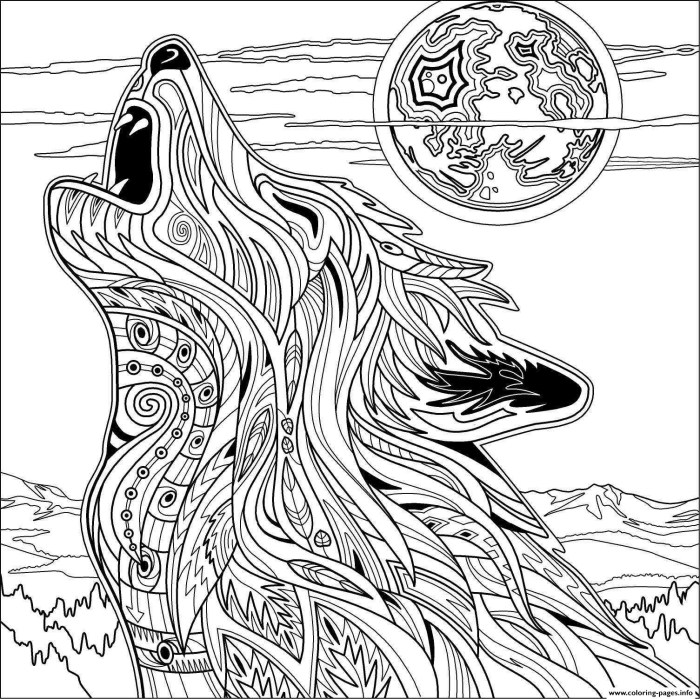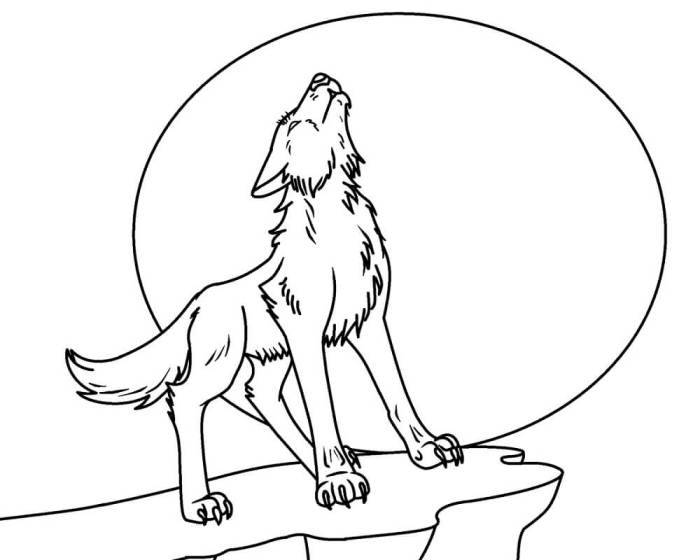Wolf Anatomy for Coloring Pages

Animal faces coloring pages wolf – Creating compelling wolf coloring pages requires understanding the animal’s key facial features. This will allow for both accurate representations and simplified versions suitable for various age groups and skill levels. The following sections detail how to approach illustrating a wolf’s face for coloring, focusing on both realistic and simplified designs.
Detailed Wolf Face Illustration
This illustration aims for anatomical accuracy, showcasing the wolf’s expressive features. The wolf’s head is presented in a three-quarter view, allowing for a dynamic pose. The eyes are almond-shaped, slightly slanted, and deeply set, conveying intelligence and alertness. The pupils are small and round, characteristic of a predator’s vision. The nose is large and black, with a slightly wet appearance, highlighted by subtle shading to indicate depth and texture.
The mouth is slightly open, revealing sharp, pointed teeth, adding to the wolf’s predatory look. The fur is depicted with variations in texture; around the eyes and muzzle, the fur is short and smooth, while longer, more textured fur is shown around the cheeks and jawline, creating a sense of depth and volume. Shading is used to create highlights and shadows, enhancing the three-dimensionality of the face.
The ears are erect and pointed, showing alertness. The overall effect is a detailed, realistic representation of a wolf’s head, perfect for older children and adults who enjoy intricate coloring projects.
Simplified Wolf Face Illustration
This simplified version focuses on large, easily colorable shapes, making it ideal for younger children. The wolf’s face is presented in a frontal view, with large, circular eyes that dominate the face. The nose is a simple, large black triangle, and the mouth is a simple curved line. The ears are large, rounded triangles, positioned high on the head.
The fur is represented by simple, solid shading, without intricate detail. The overall effect is a friendly, cartoonish representation of a wolf, perfect for younger children to color without frustration.
Step-by-Step Guide to Drawing a Wolf Face, Animal faces coloring pages wolf
This guide breaks down the process of drawing a wolf face into manageable steps, suitable for both beginners and experienced artists.
- Step 1: Basic Shapes: Begin by sketching a circle for the head. Add a smaller circle slightly below and overlapping the first for the muzzle. Draw two slightly curved lines below the muzzle to indicate the jawline. Add two upright triangles for the ears on top of the head circle.
- Step 2: Refining the Shapes: Refine the shapes to create a more wolf-like appearance. Smooth out the circles and adjust the angles of the ears and jawline. Sketch in the basic shape of the eyes, nose, and mouth.
- Step 3: Adding Details: Add details to the eyes, nose, and mouth. Sketch in the pupils of the eyes, giving them a slightly slanted almond shape. Draw a large, black nose, with subtle shading to suggest a three-dimensional form. Sketch in the mouth, indicating teeth if desired. Add fur texture by sketching short lines or strokes around the eyes and muzzle, and longer strokes around the cheeks and jawline.
Engaging with animal faces coloring pages, particularly those featuring wolves, offers a fun way to explore the intricacies of nature. This activity can even spark an interest in the underlying biological structures; for instance, comparing the cellular makeup of a wolf, you might want to check out this resource on animal and plant cell coloring and comparison to understand how these cells differ from plant cells.
Returning to the wolf coloring pages, the detailed features allow for a deeper appreciation of the animal’s unique characteristics.
- Step 4: Final Touches: Refine the details and erase any unnecessary guidelines. Add shading to create depth and highlight areas to bring the wolf face to life. Consider adding some background elements such as trees or a moon to enhance the scene.
Variations in Wolf Appearance: Animal Faces Coloring Pages Wolf

Wolves, despite their shared genusCanis lupus*, exhibit a remarkable diversity in appearance across their various subspecies and populations. This variation is largely driven by adaptation to different environments and selective pressures, resulting in distinct facial features that can be readily observed. These differences extend beyond simple coat color, encompassing skull shape, muzzle length, and even eye shape.
Subspecies Facial Feature Comparison
The following Artikels key differences in the facial features of three distinct wolf subspecies: the Arctic wolf (*Canis lupus arctos*), the Gray wolf (*Canis lupus lupus*), and the Red wolf (*Canis lupus rufus*). Understanding these variations allows for a deeper appreciation of the evolutionary adaptations within the
Canis lupus* species.
- Arctic Wolf (*Canis lupus arctos*): Characterized by a predominantly white coat, providing exceptional camouflage in snowy environments. Their muzzles are relatively short and broad, and their eyes are often a deep amber or yellow. The fur is thick and dense, providing crucial insulation against extreme cold.
- Gray Wolf (*Canis lupus lupus*): Exhibits a wider range of coat colors, from gray and brown to black, depending on their geographic location. Gray wolves possess a longer, more tapered muzzle compared to the Arctic wolf. Their eye color can vary, but shades of brown and yellow are common. The fur is generally less dense than that of the Arctic wolf.
- Red Wolf (*Canis lupus rufus*): Distinguished by their reddish-brown coat, which provides camouflage in their woodland habitats. Their muzzle is of intermediate length, falling between that of the Arctic and Gray wolf. Eye color tends to be amber or yellowish-brown. The fur is relatively shorter and less dense compared to the Arctic wolf.
Coloring Page Designs: Wolf Subspecies
The following describes three coloring page designs, each showcasing the unique facial features of a different wolf subspecies. Arctic Wolf Coloring Page: This design emphasizes the Arctic wolf’s thick, white fur, short broad muzzle, and deep amber eyes. The fur texture could be suggested through varying shades of white and light gray. The ears are relatively small and rounded, contributing to the overall rounded appearance of the head.
The expression could be depicted as alert and watchful, characteristic of a predator in its environment. Gray Wolf Coloring Page: This design will showcase the variation in coat color possible in Gray wolves. The coloring page could depict a gray wolf with a mix of gray, brown, and black fur, highlighting the variations within a single individual. The muzzle is longer and more pointed compared to the Arctic wolf.
The eyes are depicted as a lighter shade of brown or yellow. The ears are slightly larger and more pointed than those of the Arctic wolf. Red Wolf Coloring Page: This design focuses on the distinctive reddish-brown coat of the red wolf. Various shades of brown and reddish-orange could be used to represent the wolf’s fur. The muzzle is intermediate in length and shape between the Arctic and Gray wolf.
The eyes are depicted as a warm amber or yellowish-brown. The ears are of medium size, slightly smaller than the gray wolf but larger than the Arctic wolf.
Facial Feature Comparison Table
This table summarizes the key differences in facial features among the three wolf subspecies.
| Feature | Arctic Wolf | Gray Wolf | Red Wolf |
|---|---|---|---|
| Fur Color | Predominantly white | Variable (gray, brown, black) | Reddish-brown |
| Eye Shape | Round | Slightly almond-shaped | Round to slightly almond-shaped |
| Muzzle Length | Short, broad | Long, tapered | Intermediate |
General Inquiries
What kind of paper is best for these coloring pages?
Heavier weight paper, such as cardstock, is recommended to prevent bleed-through, especially when using markers or watercolors.
Are these coloring pages suitable for all ages?
Yes, the designs range in complexity, offering options suitable for young children and more advanced colorists.
Can I use these coloring pages for commercial purposes?
The usage rights depend on the specific license under which these pages are distributed. Please check the licensing agreement for details.












